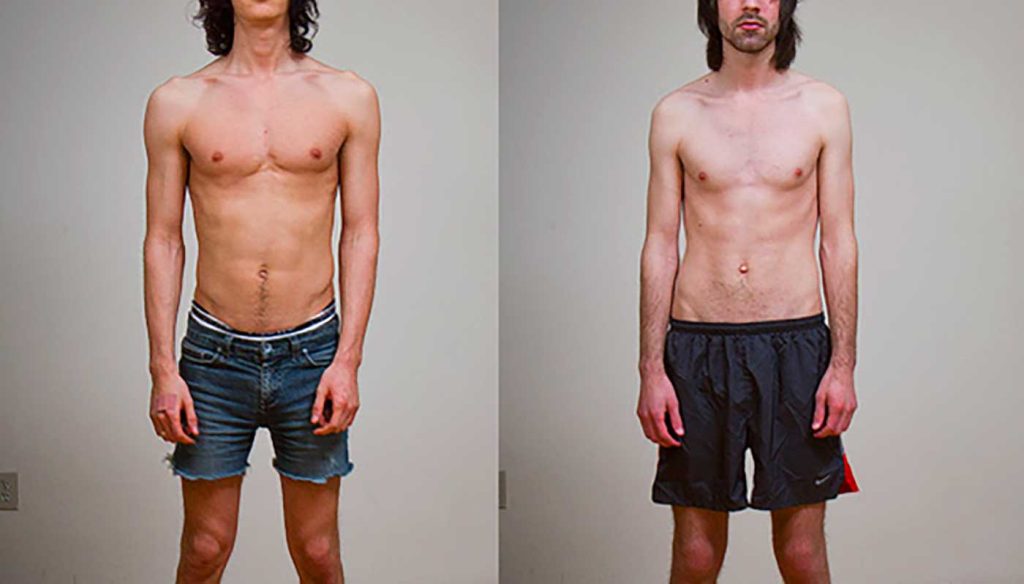
How We Went From Skinny to Muscular (+70 Pounds of Muscle)
Jared and I were skinny graphic designers. We didn’t know anyone who ate a good diet, lifted weights, or exercised. We didn’t know anyone fit or muscular. But I was clinically underweight and suffering from early signs of cardiovascular disease, and Jared had crippling tendonitis that prevented him from working his desk job.
We didn’t know anything about building muscle. I thought we could gain all the muscle we needed with a 30-day bulking challenge, and I convinced Jared to try it with me. That’s how “Muscle May” began. That’s what inspired our entire Bony to Beastly business.
After 30 days, we’d gained over thirty pounds between us. It was working. We were finally gaining weight! So we doubled down, extending our pact for another three months. By the end of those three months, we’d gained almost 60 pounds of muscle between us. Since then, I’ve gained another 30 pounds.
Here’s the full story of how we went from skinny to muscular.
- The Problem With Muscle-Building Transformations
- Our Skinny “Before” Photos
- Our Starting Measurements
- Finding a Bulking Program
- Our First Taste of Muscle Growth
- Our Workout Routines
- Our Bulking Diets
- Marco Joins the Team
- Our Bulking Mistakes
- Our Three-Month Bulking Results
- Finishing With A Cut
- Our “After” Photos & Measurements
- The Birth of Bony to Beastly
- More Bulking Transformations
- Gaining 70 Pounds
- Conclusion
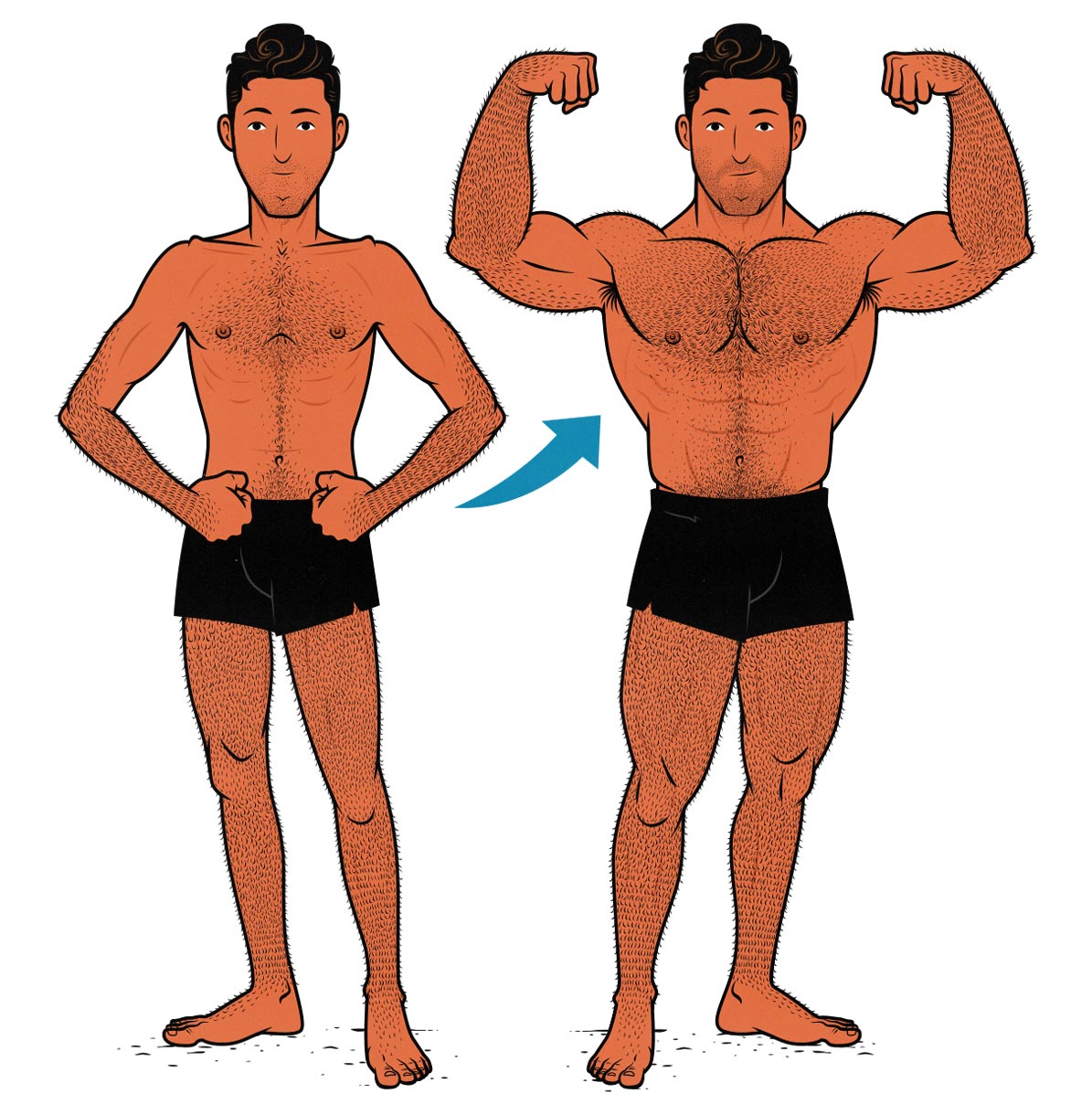
The Problem With Muscle-Building Transformations
As a naturally skinny guy, my biggest pet peeve was looking at “muscle-building” transformation photos and seeing buff guys who burned off some fat to reveal the muscle that had been there all along. It’s like Clark Kent taking off his glasses. That’s not a muscle-building transformation; that’s a fat-loss transformation.
With “bulking” transformations, there was a trend of guys losing weight when they went travelling or got sick. They’d take their before photos at these low points. Then they’d regain the muscle they’d lost and call it a skinny-to-muscular transformation. In reality, it was a muscle regrowth transformation.
The most famous celebrity is when Christian Bale bulked up for Batman, regaining the 100 pounds he lost after losing weight for the Machinist:
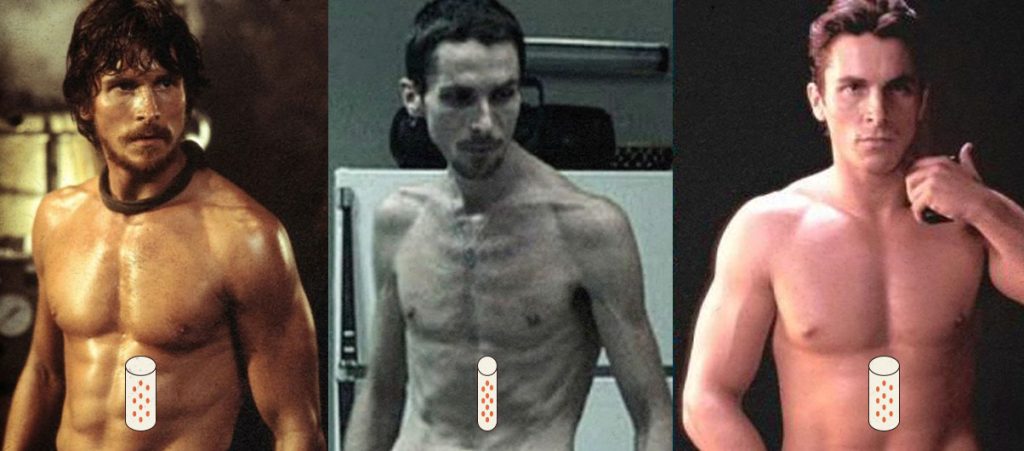
The most famous bodybuilding example is when Casey Viator got an infection, had an allergic reaction to the medicine he took, and lost dozens of pounds of muscle (while presumably stopping his PEDs). When he started training again (and presumably resumed his PED abuse), he regained the 60 pounds of muscle he’d lost:
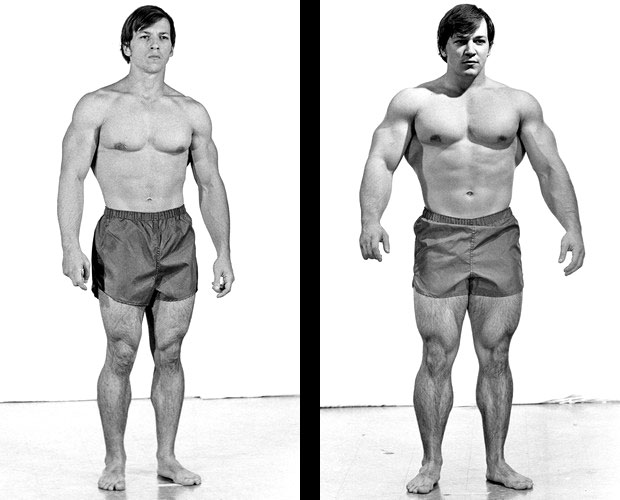
And then there’s Tim Ferriss. He built muscle from a lifetime of wrestling and playing sports, lost muscle mass while travelling and learning to dance, and then regained all the muscle he lost in a single month, going from “Geek to Freak”:
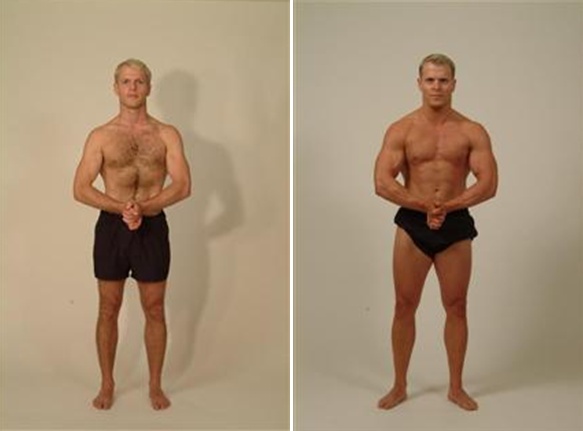
These transformations aren’t always misleading or deceitful. Tim Ferriss clearly explained his training history. He was always honest about regaining lost muscle mass. That’s fine. And I like Tim Ferris. His blog is part of what inspired Jared and me to start our graphic design firm. His “Geek to Freak” transformation gave us the idea for our “Bony to Beastly” brand name. But as a lifelong skinny guy looking, I couldn’t relate to his before-and-after photos.
Our Skinny “Before” Photos
We were tired of all of the tricks, and we didn’t have anything to sell or anything to prove. We were graphic designers. I thought it would be cool to see what would happen if two everyday skinny guys documented their bulking results while working at their desk jobs.
Jared and our other roommate, Payam, had some experience as photographers. They came up with a system to take consistent progress photos:
- Same lighting.
- Same poses.
- Same time of day (first thing in the morning).
- Same stomach contents (after peeing, with one small glass of water).
- No pumping up our muscles.
- No tricks at all.
So, first, before we talk about our 4-month bulking transformation, let’s give a little backstory. Here I am at 21 years old, wearing a size small T-shirt:

I fluctuated between 120–130 pounds at a height of 6’2. On the very best of days, that put my BMI at 17, which is considered clinically underweight. If you’re curious about your own BMI, you can check yours here.
I wasn’t just skinny in the sense that I wasn’t muscular. At 18, I’d been diagnosed as having a high risk of heart disease. Both my family doctor and my cardiologist had told me to eat a better diet, exercise, and gain weight.
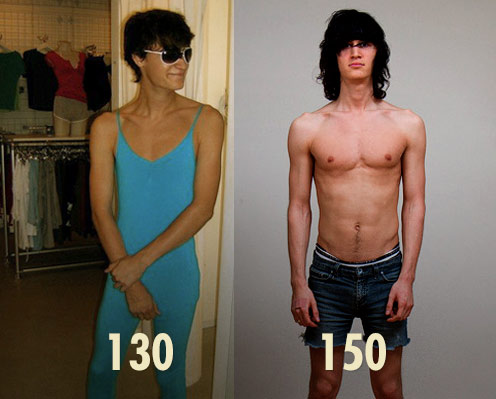
At 21, I bought a muscle-building program for “ectomorphs” and put on 20 pounds of muscle with an aggressive 3-month bulk. That brought me from 130 pounds up to 150 pounds, from a BMI of 17 up to 19. That brought me into the healthy range. I was still thin, but I wasn’t underweight anymore.
So, why am I telling you all of this?
- First, my “before” photos show me in peak condition—the most muscular I’d ever been in my entire life. When I started this 4-month bulking transformation, I’d already gained 20 pounds. There’s no muscle regrowth happening here.
- Second, I’d already gotten my “newbie gains.” If you haven’t heard that term before, newbie gains are the muscle gains that come easily when people first start bulking up.
The other nice thing about having already gained 20 pounds was that I knew a little bit about how to build muscle: I already knew the basics of how to lift weights, eat a bulking diet, and live a healthy lifestyle. Jared had watched me gain those 20 pounds. That’s why he agreed to be my training partner. He already knew it could work.
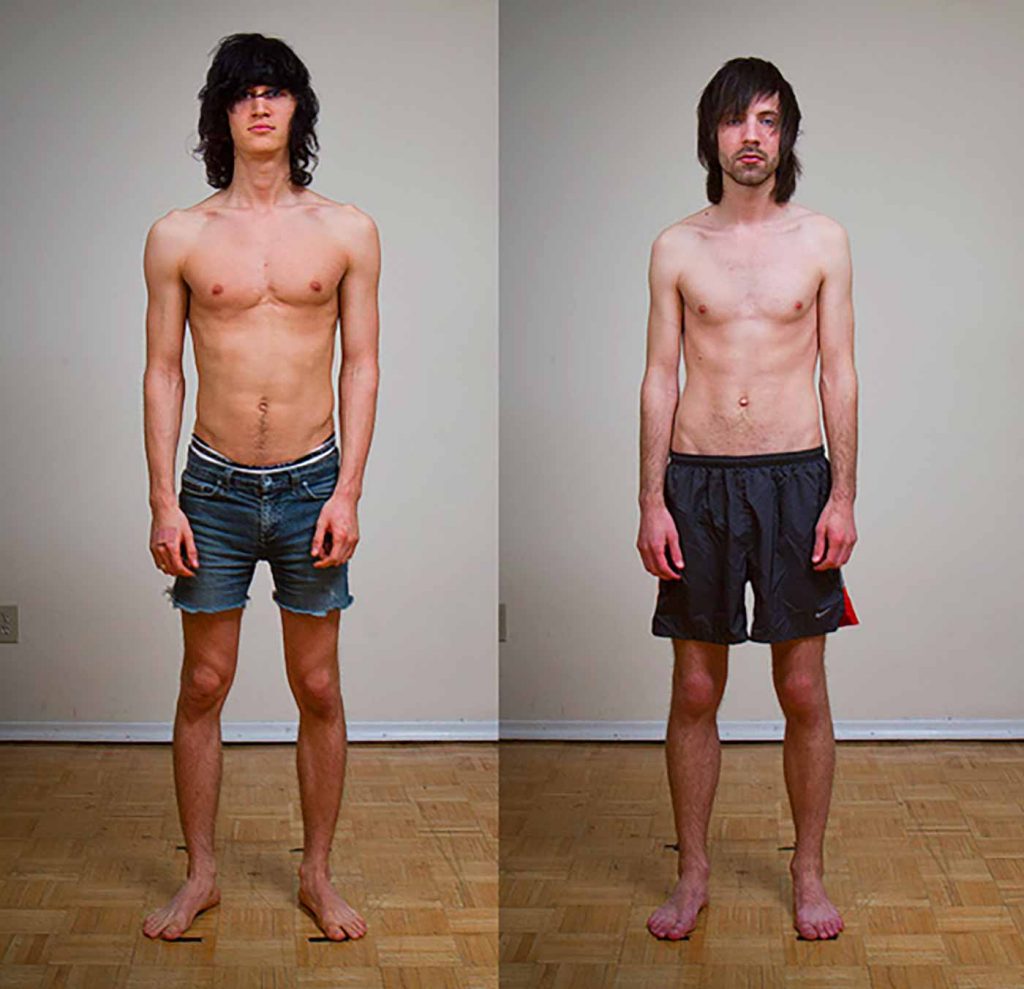
Here are our official “before” photos. I weighed 150 pounds. Jared weighed 130. This was the heaviest we’d ever weighed, the best shape we’d ever been in. And we were fully grown, adult men who’d already been through puberty.
Our Starting Measurements
Here are me starting measurements at 6’2 and 150 pounds:
- Neck: 14.25 inches
- Shoulders: 43.5 inches
- Biceps: 12.25 inches
- Chest: 37 inches
- Waist: 30 inches
- Hips: 36 inches
- Thigh: 18.75 inches
- Calf: 13.5 inches
Now, keep in mind that I’d already gained twenty pounds. At 130 pounds, my neck had been just under 14 inches, my biceps had been just under 10 inches, and my shoulders had been just under 39 inches.
As you can see, I’d spent more time on my shoulders, chest, and arms than on my legs. I had tried squatting and deadlifting, but my technique was horrible, and I had given up on it. This is what skipping leg day looks like.
Here are Jared’s measurements at 6 feet and 130 pounds:
- Neck: 13.75 inches
- Shoulders: 38.75 inches
- Biceps: 11 inches
- Chest: 33.75 inches
- Waist: 27.5 inches
- Hips: 35.5 inches
- Thigh: 18.75 inches
- Calf: 13.75 inches
Jared’s measurements were similar to how mine had been the year before, except with slightly bigger arms and legs. We later discovered that my torso grew more easily, making me “torso dominant,” whereas Jared’s arms few more easily, making him “limb dominant.” That affected which isolation exercises we focused on going forward.
Finding a Bulking Program
Now that we had our “before” photos, we had to figure out how to get “after” photos. We needed a muscle-building routine to follow. We had to find a workout program designed to stimulate muscle growth and a good bulking diet designed for gaining weight.
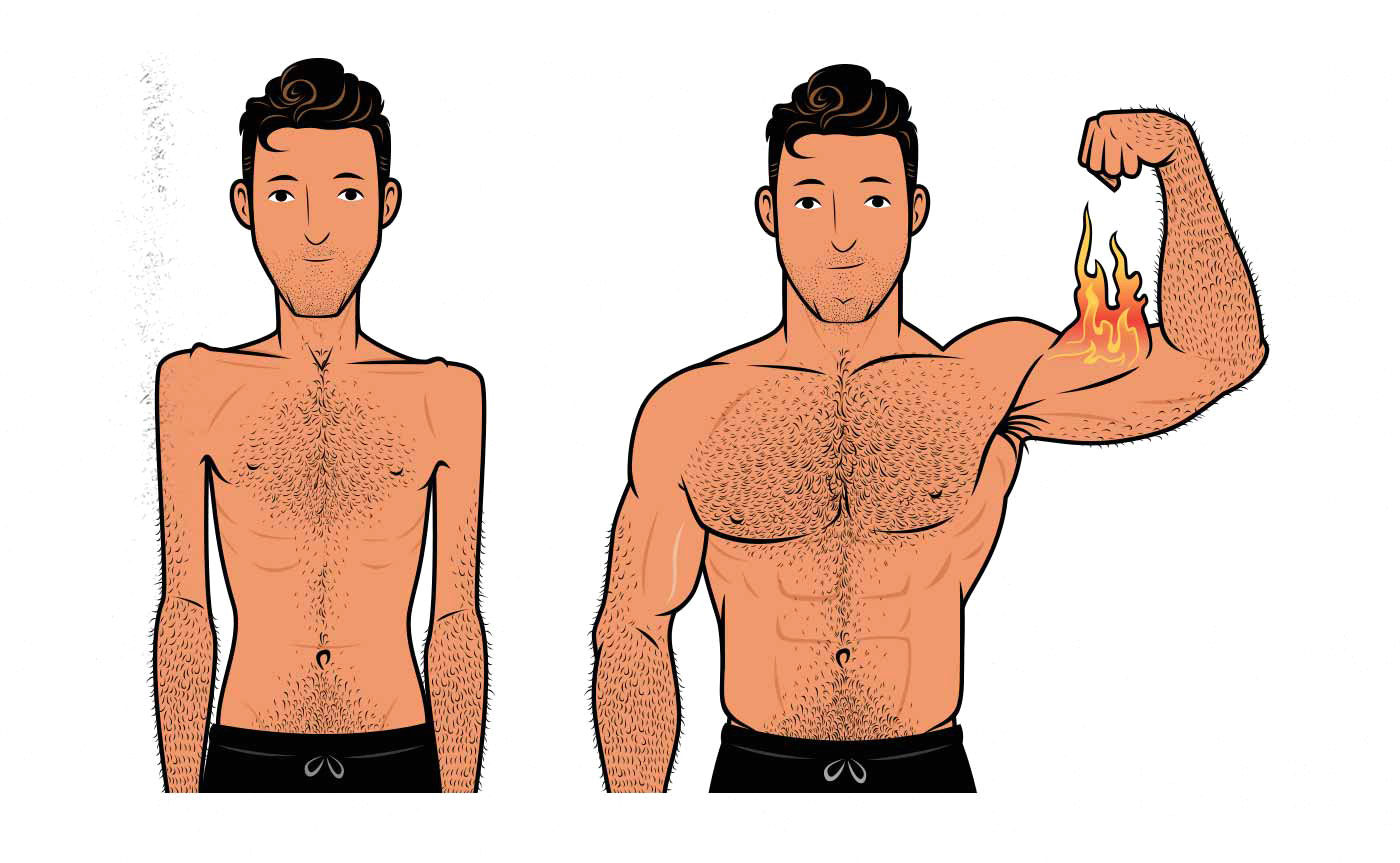
At first, it was discouraging because everything was targeted at overweight people looking to lose fat, not at skinny guys trying to build muscle. Things have gotten better since then. The skinny niche has expanded. I like to think we were a pivotal part of that.
Back then, naturally skinny guys were called “ectomorphs.” Once I figured out that word, I started finding tips for skinny guys. That’s where I learned the term hardgainer—someone who has trouble eating enough food to gain weight. And about hypertrophy training—training to gain muscle size.
I also learned about “non-responders.” Most weight training studies don’t standardize the diets. This creates a problem for skinny guys with small appetites. We don’t intuitively eat enough food to support muscle growth, so we don’t gain any muscle, and we get labelled as non-responders. It feels like we have poor muscle-building genetics, but that isn’t the case. With a good bulking diet, we can build muscle just fine.
Our First Taste of Muscle Growth
We treated all of this as an experiment. Partly because that gave Jared and Payam an excuse to track and photograph everything. But mainly because we were too ashamed to tell our friends and family that we were trying to build muscle. We figured “We’re doing an experiment” sounded cooler than “We’re sick of being skinny.”
As we blogged about our muscle growth, we started gaining attention on bodybuilding.com. Our 90-day progress video got 300,000 views on YouTube. Plenty of people were building muscle, but it was rare to see such skinny guys gaining weight so quickly, building muscle so leanly. Remember, this was 13 years ago. The online fitness industry was still young.
Some of the attention was good, some bad. On the bad side, I realized that wearing “daisy dukes” (cut-off jean shorts) in my progress photos wasn’t an appropriately masculine choice. But on the good side, we had dozens of skinny guys emailing us asking for advice. I explained our routine and diet, and I answered all their questions. That became the very first version of our Bony to Beastly Program.
Three months into our bulk, even the personal trainers at the gym were starting to notice how quickly we were growing. We’d been lifting quietly in the corners during our first few weeks in the gym, so getting congratulated by the staff felt amazing.
Our Workout Routines
I’d used a workout routine designed by Anthony Ellis during my first bulk. We modified that routine for our second bulk. It was a 3-day “Bro Split,” meaning we had a Chest Day (for our chests, shoulders, and triceps), a Back Day (for our backs and biceps), and a Leg Day (for our legs and abs). A full-body workout routine would have suited us better. But it didn’t matter.
We didn’t have the best workout routine, and our lifting technique wasn’t very good, but we gave each workout our best effort, and that was more than enough to stimulate muscle growth.
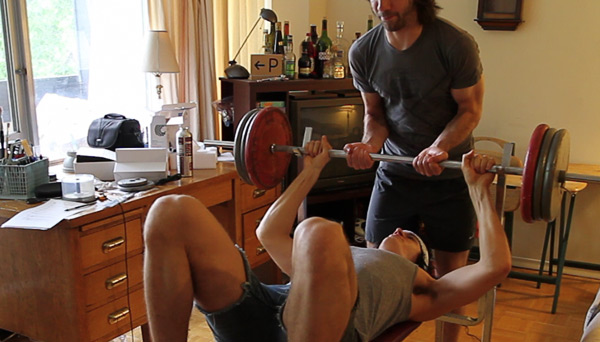
We were determined not to miss a single workout, either. When the gym shut down for renovations, we made a makeshift home gym out of a rickety bench press I found on the side of the road.
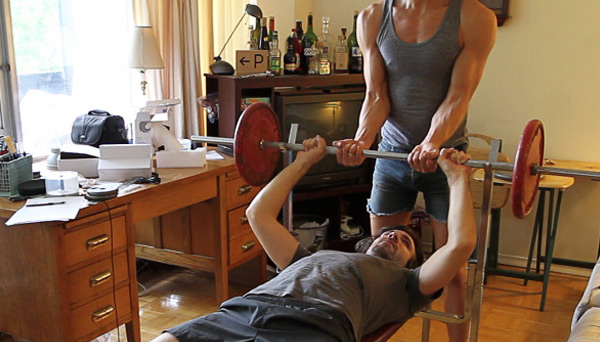
I remember looking at these and thinking our arms looked insane. They’re only around 13 inches here, but they’re so much bigger than they used to be.
Our Bulking Diets
Our bulking diets weren’t perfect, either. There was this old mass gainer supplement called Myoplex that was popular at the time. We were running our graphic design firm back then, and I remember driving to meetings with Myoplex and water bottles in the glove box. If we were too busy working to sit down for a balanced meal, we’d mix the powder into a bit of water before our meetings.
But we were consistent. We ate our three meals and two snacks every single day. Most of those meals were things like chili con carne, stew, lasagna, fish and potatoes, cottage cheese with strawberry jam, muesli cereal, and Greek yogurt with berries. We were getting all the nutrients and calories we needed. And it was working. We were gaining weight on the scale every week.
Here’s what made our bulking diet work so well:
- We were eating enough calories to gain weight at a good pace. with 500-1000 extra calories per day, we found that we were gaining somewhere between 0.5–2 pounds per week, depending on the week. We weren’t perfectly precise, but it was enough to result in steady growth.
- We were eating enough protein to build new muscle tissue at a maximal rate. Our workouts were stimulating muscle growth, but we needed to make sure that our protein intake wasn’t a limiting factor. Most research shows that 0.8 grams of protein per pound bodyweight is enough to maximize muscle growth, but we rounded that up to one gram per pound. It’s common for protein supplements to exaggerate their protein contents, and we wanted to make sure that we weren’t accidentally undershooting our protein targets.
- We got most of our calories from whole foods. We did have some weight gainer shakes, we added some maltodextrin to our workout shakes, and we took a break from our bulking diets on Sunday, but for the most part, we were eating minimally processed whole foods—oats, ground meat, trail mix, legumes, rice, milk, yogurt, potatoes, chicken, and so on.
- We ate often and made sure to have protein with each meal. Back in 2010, intermittent fasting hadn’t become popular yet, and thankfully so—fasting isn’t good for building muscle, eating is. We were eating 4–6 meals per day, each containing at least twenty grams of protein. Modern research has shown that this increases our rate of muscle growth, but back then, we just kind of lucked into it. Bodybuilders found it easier to digest smaller meals and snacks, so they ate often.
- We ate plenty of carbs. Low-carb and ketogenic diets weren’t popular yet, and again, that was a good turn of luck. Eating plenty of carbs is great for muscle growth, as you can see in this study, as shown here.
- We started most days with bulking smoothies, which are easy to make, gentle on the appetite, and quick to digest.
We also made our meals in bulk, cooking a big pot of chili on Sunday and reheating it during the week. We’d do the same thing with our homemade protein bars. That made our bulking diet a little easier to follow. These bulking recipes were so helpful that we included an entire bulking recipe book in our Bony to Beastly Program.
Marco Joins the Team
As Jared and I had been bulking up, we’d been blogging about our progress on our design blog. Eventually, an old friend from high school told me that I should reach out to the strength coach his university football team had hired. He was telling me that this guy was naturally skinny, had gained over sixty pounds of muscle, and was known for being able to help athletes bulk up in a hurry. He’d only just graduated with his health science degree, and he’d already helped college, professional, and Olympic athletes bulk up.
I thought this was a ridiculous idea. There was no way I was going to cold-call a university strength coach to ask for bulking advice. My friend started laughing, “But you know him already! It’s Marco!”
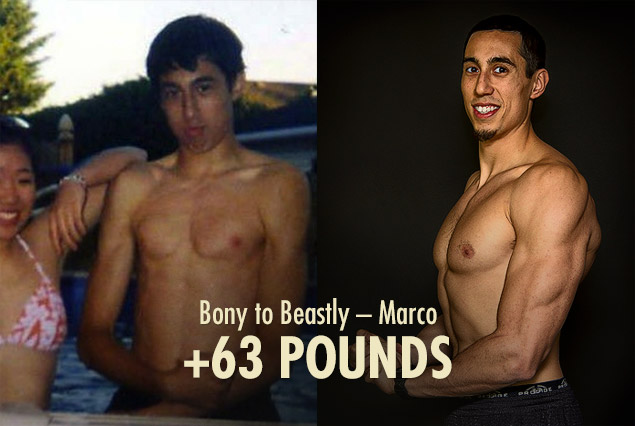
Turns out that one of my acquaintances from high school, a gentle giraffe of a guy named Marco, had bulked up to 205 pounds and was now building his reputation as a top strength coach.
While Jared and I had been studying design, Marco had been studying health sciences and working as a strength and conditioning coach. Not only that, but he’d also studied under the top strength and conditioning coaches in the world, such as Eric Cressey (the head strength coach for the New York Yankees). That expertise had launched him into a career coaching college, professional, and Olympic athletes.
When Marco and I first spoke, he congratulated us on having gained so much muscle. He didn’t point out our mistakes, he was just happy for us. But when I asked him if we were doing anything wrong, that opened Pandora’s box.
Our Bulking Mistakes
For about an hour, Marco broke down our routine and explained how we could make it better. Better in the sense that we could gain more muscle mass and strength, which is what we were interested in, but also better in the sense that we could keep our joints healthy, avoid injury, and do a better job of improving our health and posture.
He explained that he’d seen too many athletes grind their bodies down to get bigger. This is where most people get confused. They assume that lifting puts “wear and tear” on their bodies. That isn’t quite right. Lifting stresses our bodies, but we can adapt to that stress, growing stronger from it. Running and squats don’t “wear down” our knees; they help our knees grow stronger. The problem is when there’s too much stress with too little adaptation. That’s what grinds people down.
Marco made a few changes to our workout routine and bulking diet:
- He put us on a full-body workout routine. And since I’d already read about those benefits, I was stoked to try it.
- Every workout started with a pair of compound lifts, such as squats and chin-ups, or deadlifts and push-ups. One exercise generally required some sort of weight (dumbbell or barbell) while the other could be done with minimal equipment. This allowed us to do supersets, where you alternate between two different exercises. You’d do a set of deadlifts, catch your breath, do a set of push-ups, catch your breath again, and then go back to deadlifts. It helps you stimulate more muscle growth with shorter workouts, and it keeps your heart rate higher, provoking greater fitness adaptations.
- He chose lifts that matched our experience level. Marco saw that we couldn’t do a lot of the big barbell lifts properly yet, so he gave us easier variations to start with. For instance, we switched from back squats to goblet squats, which stimulate just as much muscle growth while teaching better squat technique.
- We stopped training to failure all the time. Instead, we’d stop 0–2 reps shy of failure. That helped us spend more of our time lifting with better technique, and it helped us with the soreness, aches, and pains.
- We were still doing isolation lifts. Unlike a lot of strength training programs that were popular at the time, such as Starting Strength and StrongLifts 5×5, Marco had us doing plenty of isolation lifts, especially for our arms. He explained that skinny guys like us need extra arm exercises if we want to build muscular arms. Plus, as beginners, doing simple lifts is an easy way to reliably challenge our muscles without being limited by coordination, balance, cardiovascular demands, or technique. We could take these smaller lifts to failure, learning how to push ourselves.
- Everything was “periodized.” Our entire training program was broken into five-week routines called “phases.” Each phase started with fewer sets per muscle, preventing excess muscle damage and crippling soreness, and worked its way higher, gradually adding more sets. With each new phase, new exercises and techniques were cycled in to stimulate a new round of muscle growth before hitting a plateau.
These new bulking workouts were great. We were even doing loaded carries and a few other athletic bulking techniques, which we loved. Our upper backs and shoulders started getting a lot bigger. Our posture was noticeably improving, too, and our strength was going up by leaps and bounds.
This new way of working out also made me realize how important our training was. The more muscle growth we can stimulate with our workouts, the more nutrients our muscles gobble up, leaving fewer to spill over into fat gain. Better training yields faster, leaner muscle growth.
Our Three-Month Bulking Results
Our first month had started off a little rocky, but with Marco’s help, we were building muscle faster than we had thought was physically possible. There was this popular meme that people could only gain twenty pounds of muscle in their first year of lifting weights. It seemed like we were about to double that.
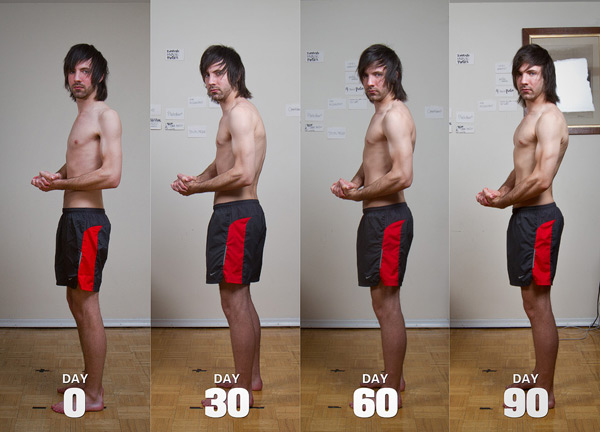
Jared had started at 130 pounds and had bulked up to 163 pounds. In three months, he’d gained 33 pounds without gaining a noticeable amount of fat. His posture improved, too, and he was no longer suffering from tendonitis when doing graphic design work at his desk.
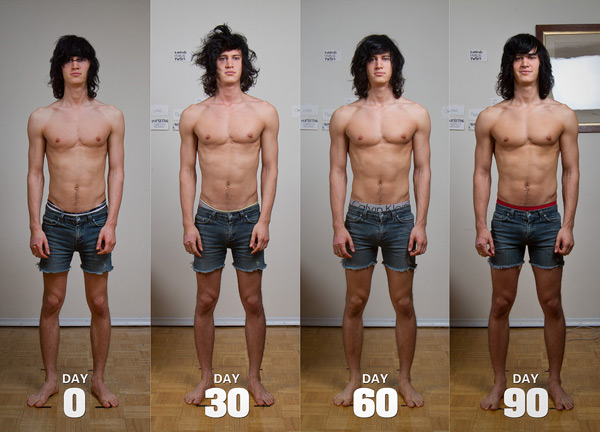
I had already gained twenty pounds before we even started, and in three months, I’d already gained another 25 pounds, bringing my total weight gain up to 45 pounds without any visible increase in fat. I was flabbergasted. It seemed like our genetics had gone from terrible to terrific overnight. We couldn’t believe it. It didn’t seem real.
It turns out that because we were starting so far away from our genetic muscular potential, we could gain muscle more quickly before running into the laws of diminishing returns, like so:
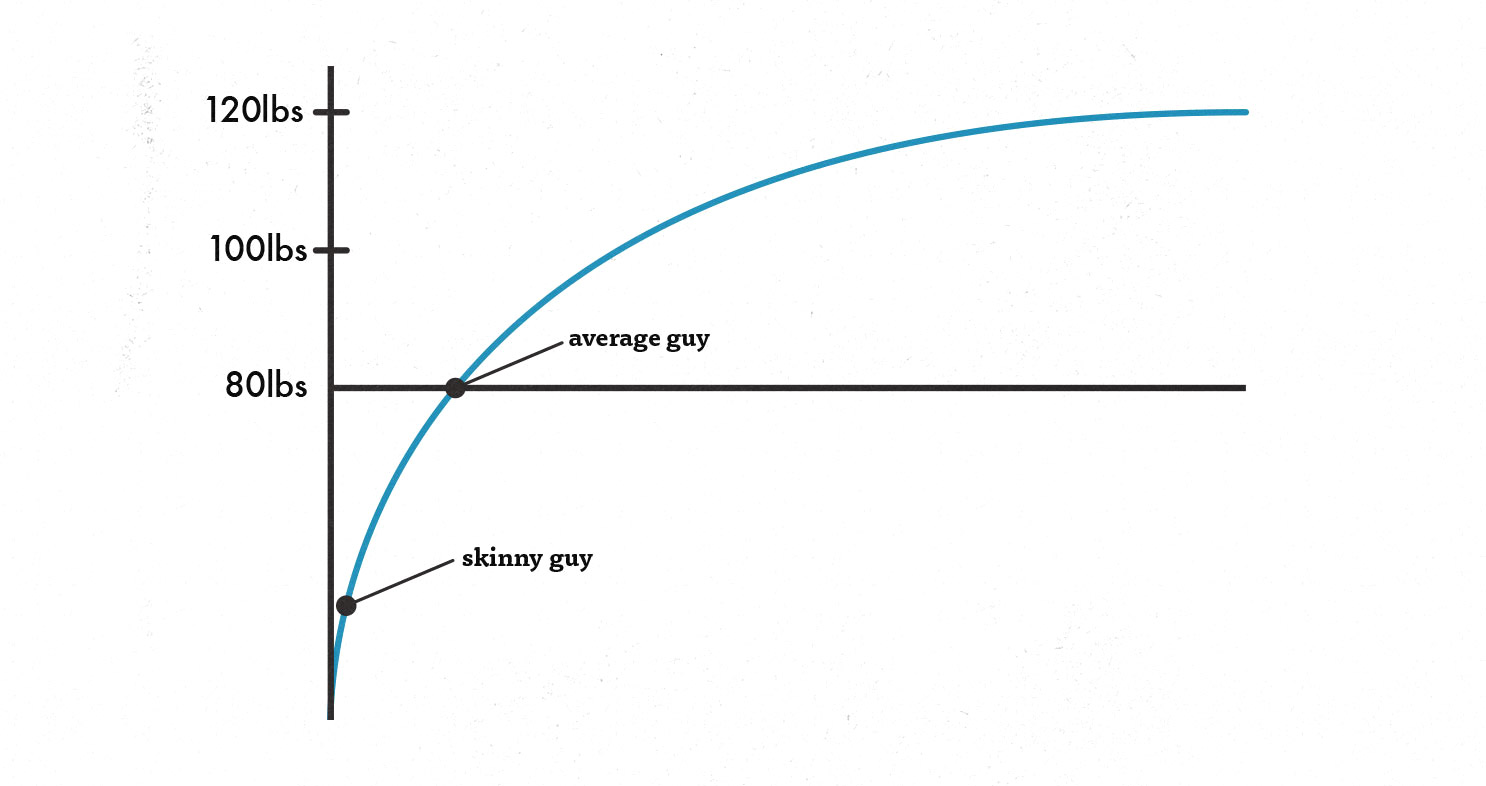
The average man starts off with roughly eighty pounds of muscle on his frame. Imagine a skinny guy (like me) starting with just forty pounds of muscle on his frame. He’s starting off behind the starting line. We aren’t defying the laws of muscle growth or anything, we were just catching up to the muscularity of the average guy (and then eventually moving beyond, but with normal rates of muscle growth from that point forward).
Finishing With A Cut
Our bulk had gone well, and we were by no means feeling fat, but we had initially planned to do a traditional bulking and cutting cycle, as bodybuilders do. The idea was to spend a few months slowly building muscle while gaining fat (bulking), then burn away the extra fat (cutting).
Bulking had been going great, and we could have kept going, but we were also sick of overeating. We wanted a change of pace. Even though we hadn’t gained as much fat as we expected, we decided to gear into a cut anyway.
For the next four weeks, we combined our hypertrophy workouts with a bit of extra cardio, and we radically reduced our calorie intake, going from gaining 1–2 pounds per week (a calorie surplus of 500–1000 calories) to losing 1–2 pounds per week (a calorie deficit of 500–1000 calories per week). We loved it. After so much time spent feeling full, hunger was a breath of fresh air.
Our “After” Photos & Measurements
I started the bulk at 150 pounds, bulked up to 175 pounds, and then cut down to around 167 pounds. If you add these results to my first bulk, I was 40 pounds heavier than I’d been the year before, and I was leaner than I’d ever been in my life. My chest, traps, shoulders, and legs had exploded.
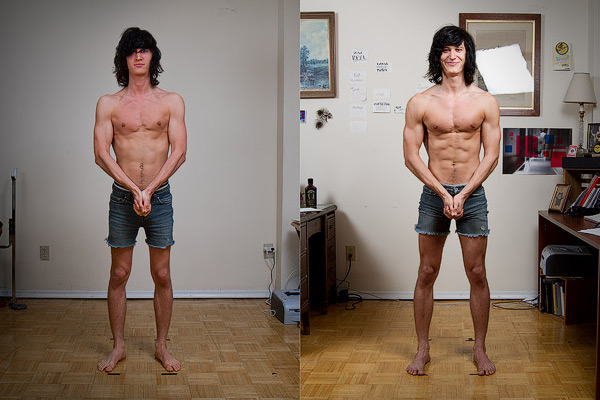
Note that these are the same shorts. I didn’t cut them shorter. What happened is that my glutes grew, pulling them up higher in the back. All of my clothes fit differently. I had to throw away my small T-shirts and buy medium ones, then large ones.
Here are my before-and-after measurements:
- Body Weight: 150lbs to 167lbs (+17 pounds)
- Neck: 14.25″ to 14.5″ (+0.25 inches)
- Shoulders: 43.5″ to 47.5″ (+4 inches!)
- Bicep: 12.25″ to 13.25″ (+1 inch)
- Chest: 37″ to 38.25″ (+1.25 inches)
- Waist: 30″ to 29.25″ (-0.75 inches)
- Hips: 36″ to 37.25″ (+1.25 inches)
- Thigh: 18.75″ to 21″ (+2.25 inches)
- Calf: 13.5″ to 14″ (+0.5 inches)
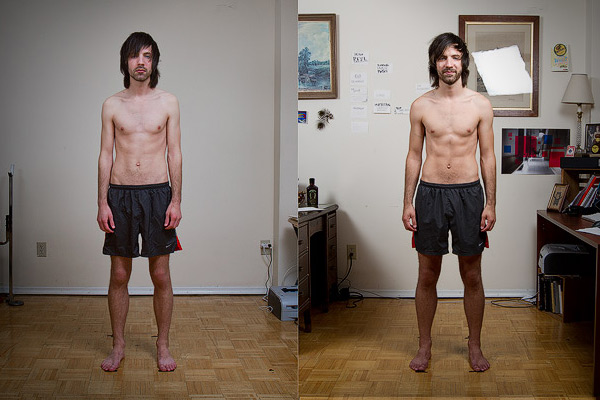
Jared started at 130 pounds and bulked up to 167 pounds, then cut down to 163 pounds, gaining 33 pounds overall. He started with a faint hint of abs and finished with well-defined abs.
- Body Weight: 130lbs to 163lbs (+33 pounds)
- Neck: 13.75″ to 14.25″ (+0.5 inches)
- Shoulders: 38.75″ to 41″ (+2.25 inches)
- Bicep: 11″ to 12.5″ (+1.5 inches)
- Chest: 33.75″ to 35.25″ (+1.5 inches)
- Waist: 27.5″ to 29.25″ (+1.5 inches)
- Hips: 35.5″ to 37″ (+1.5 inches)
- Thigh: 18.75″ to 22″ (+1.25 inches)
- Calf: 13.75″ to 15″ (+1.25 inches)
The Birth of Bony to Beastly
When we posted our progress photos on our design blog, they blew up. This was back in 2010, and the online fitness community was still fairly young. There weren’t many resources for naturally skinny hardgainers and ectomorphs.
We started getting even more emails from other skinny guys desperate to bulk up. They saw our progress photos and wanted to know how we had done it. It wasn’t just online, either. Our friends, families, and even strangers at the gym were coming to us for bulking advice.
I spent an entire year doing my design work from 9–5 PM and answering emails from 5–10 pm. Not every day, but a good 4–5 days per week, spending over twenty hours per week coaching these other skinny guys through their bulks.
To make coaching these guys easier, I had put our plan into a little PDF guide, including the workout routine, the diet, the lifestyle changes we’d made, and how to adjust everything based on the results they were getting. Every 5 weeks, they’d submit a new round of progress photos, and we’d talk about the next 5-week phase. Everyone loved it, and it was producing great results:
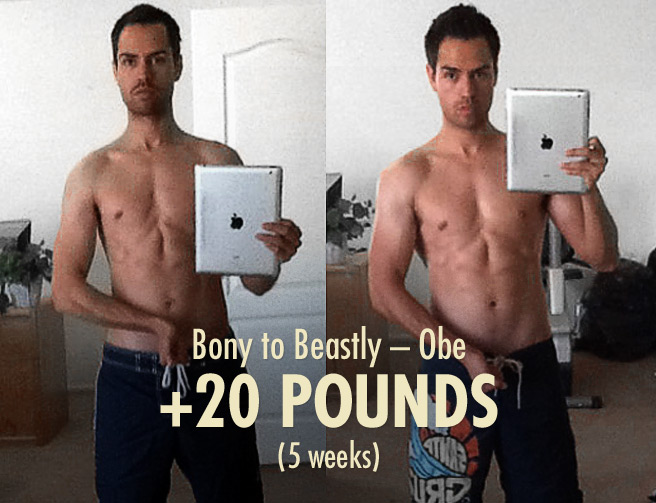
During this time, I wanted to take a break from bulking, so Marco switched me over to a strength training routine. I went from being able to bench 135 pounds for half a rep to benching 225 pounds all the way down to my chest for a set of five. My lifetime goal had been to do a single rep with 185 pounds. I couldn’t believe it.
My strength skyrocketed without my needing to gain any extra muscle mass. This suited my goals at the time, but just proved to me that strength training to gain muscle size is misguided.
After having coached a few dozen clients together during that year, Jared, Marco, and I decided to go all-in, creating The Bony to Beastly Bulking Program and building this business around it.
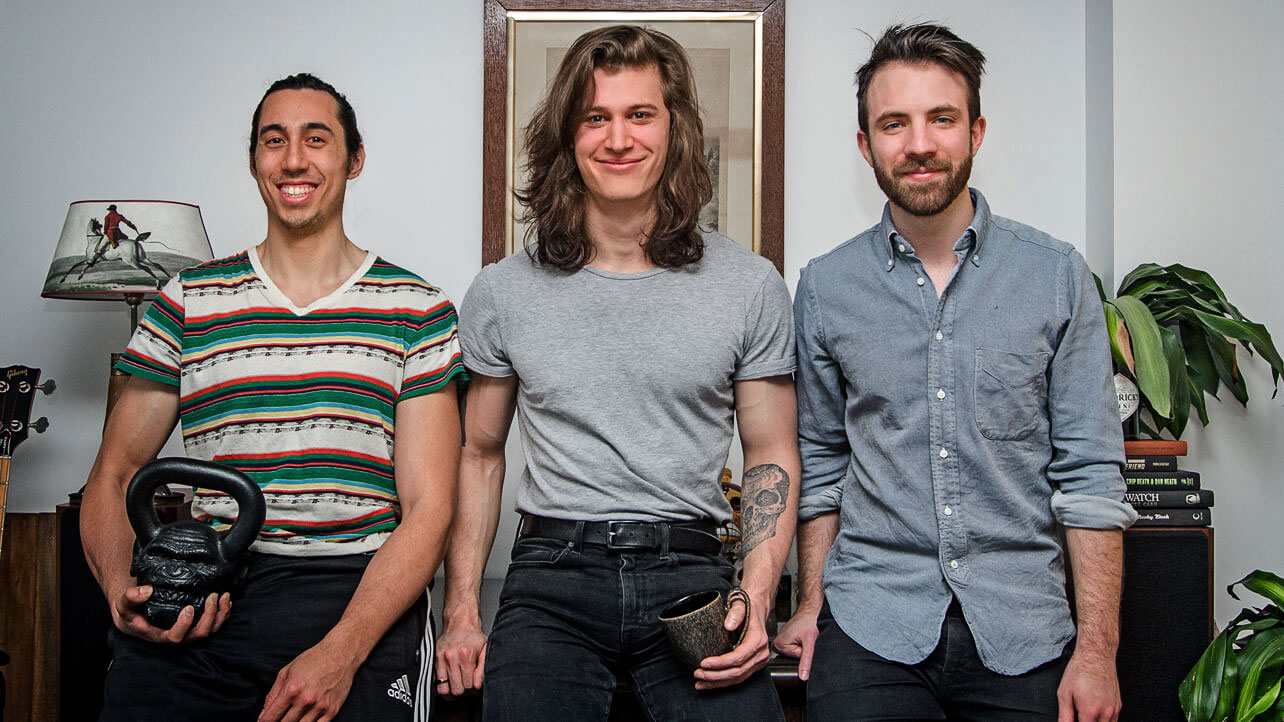
Once we had a prototype of our official bulking program, I tested it. I gained another eighteen pounds, bringing me from 167 up to 185 pounds. In just a couple of years, I’d gained 55 pounds:
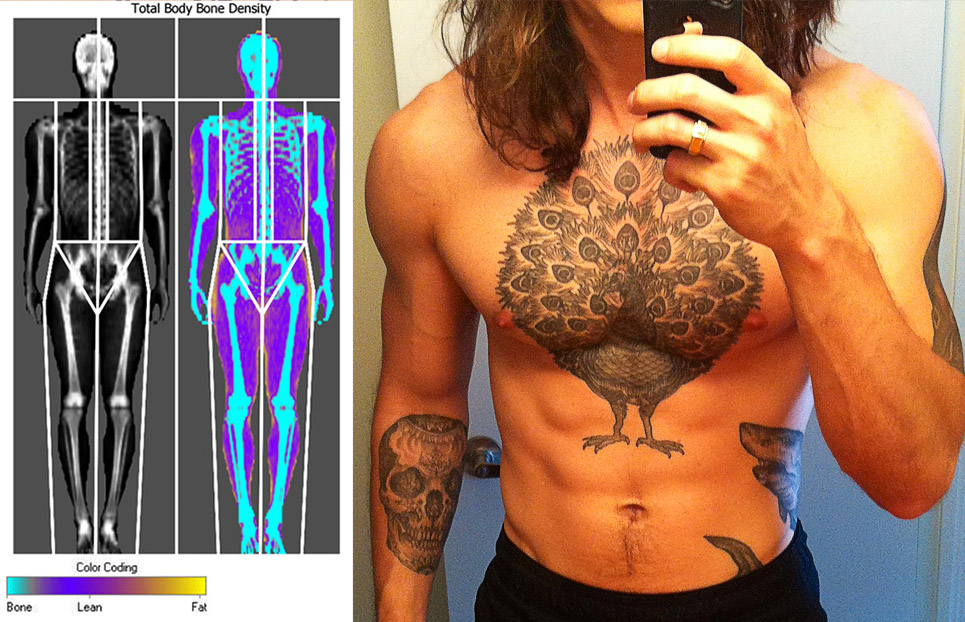
I had spent my whole life thinking that my body was too skinny to ever become strong and muscular. In a few months, I realized that my potential was far higher than that. I felt healthy and athletic. My doctor was blown away by how much my health markers had improved. I was no longer at high risk of having a heart attack. I started sleeping better, too.
More Bulking Transformations
Here’s one of our very first Bony to Beastly members, Albert. He’s a doctor who was working 80 hours per week while going through the program, often needing to rely on the hospital vending machines for his meals. But he wanted to set a good example for his patients, he was determined to go from skinny to muscular, and he managed to gain 25 pounds while finishing even leaner than when he started:
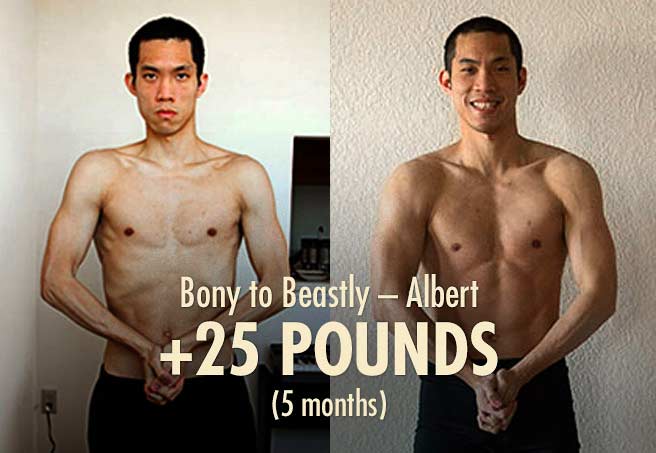
Our bulking routine was five months long, but just to be clear, Albert took longer than five months to finish it. He took a few breaks from exercising when work got hectic. But the above photo shows five months of doing the bulking routine.
Here’s another great example from GK, showing how quickly and leanly ectomorphs can build muscle:
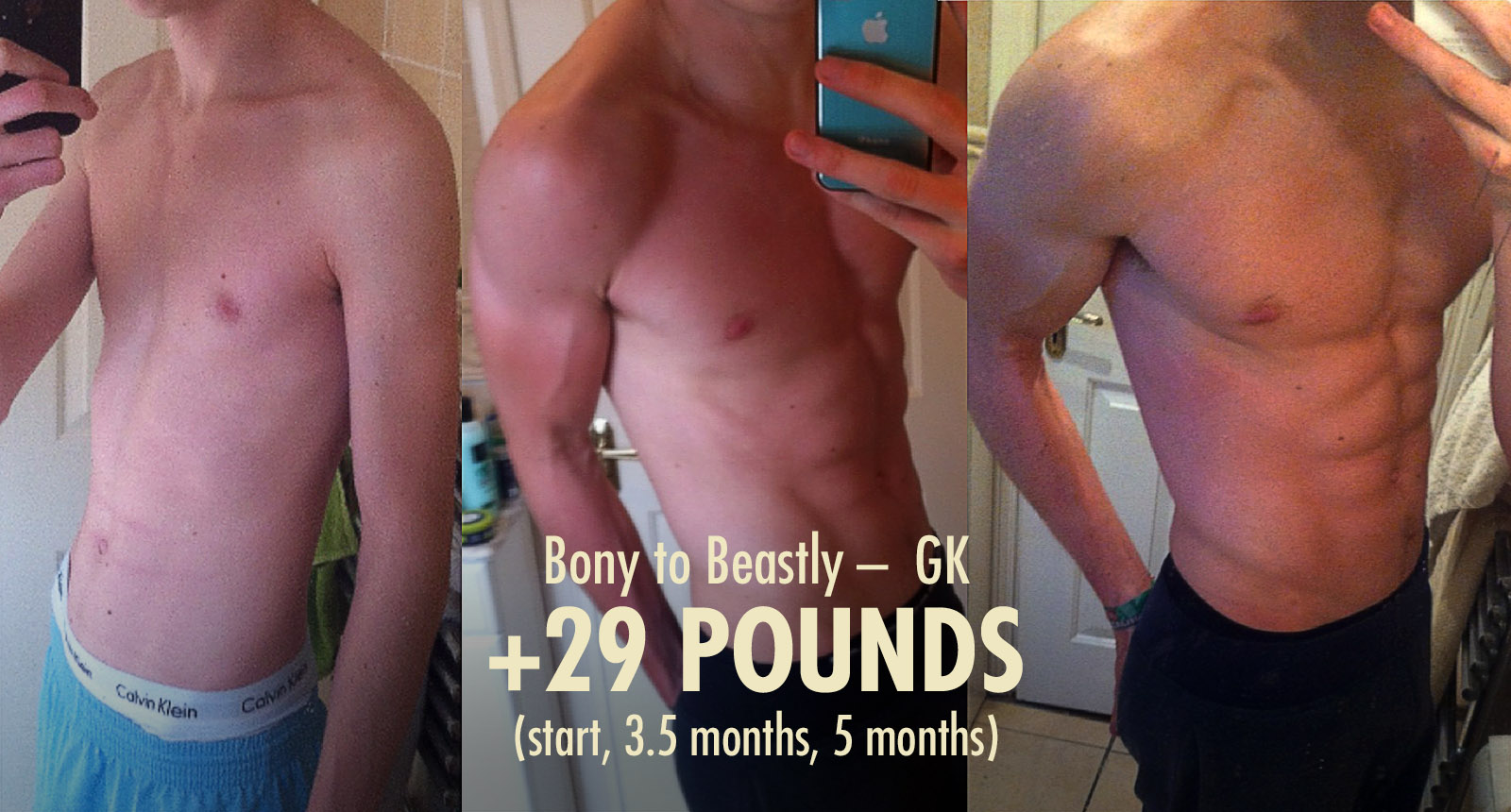
And here’s one of my favourites, Klaus, who started out skinny-fat and totally transformed his physique by building muscle and losing fat, finishing 22 pounds heavier than when he started:
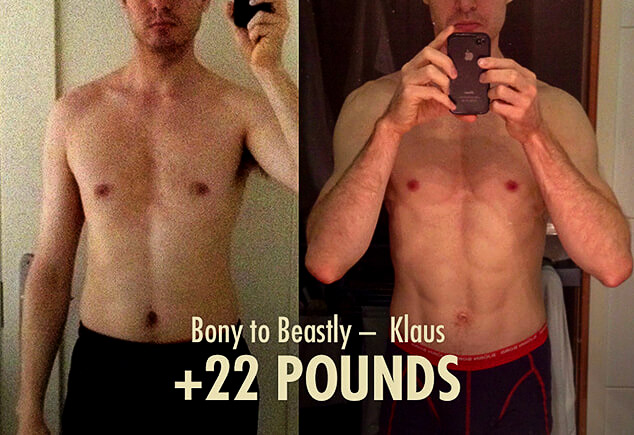
Here’s Ariel’s skinny to muscular transformation. He’s a great example of building broader shoulders:
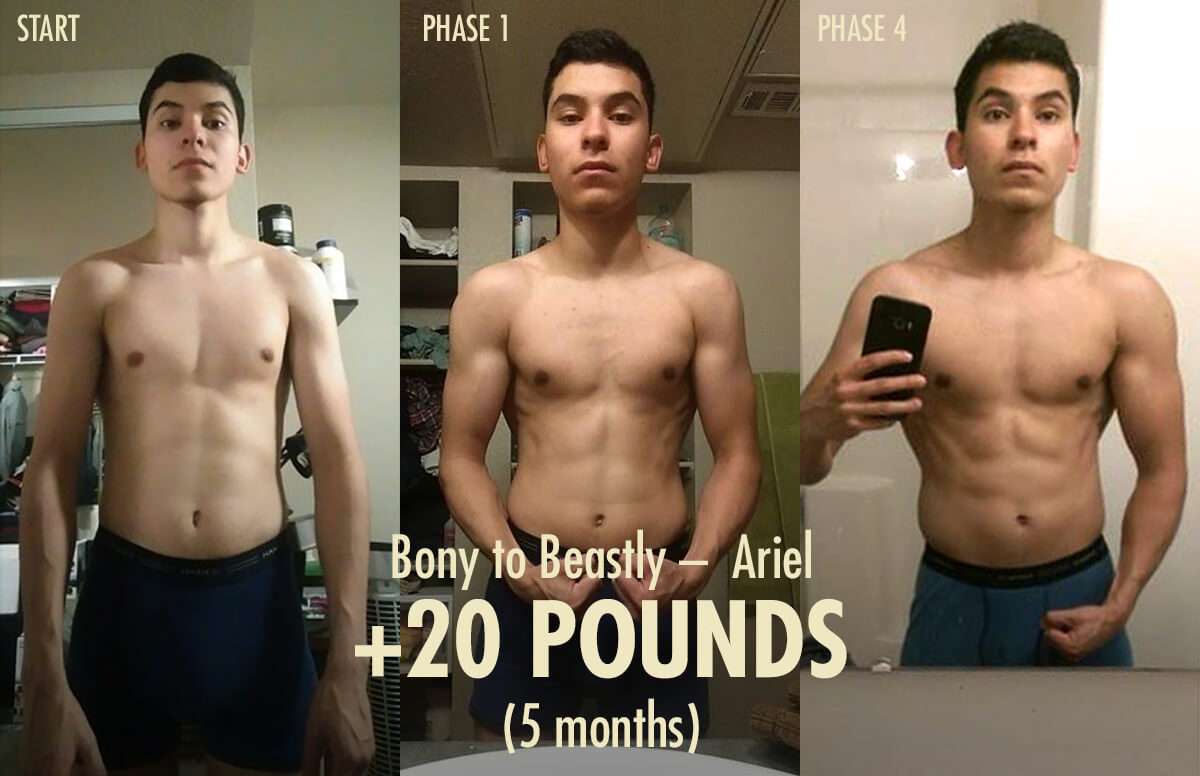
Over the years, we’ve improved and refined the program. We’ve run nearly 15,000 guys through the program now, and we’ve remade the program 3 times, making major overhauls with each major update.
Gaining 70 Pounds
We still try to walk the walk. I’ve gotten married and had my first son. Even after all these years, I’m still feeling grateful that I took the effort to bulk up. It’s helped me live a productive and healthy life, and I get to feel like a strong husband and father.

If I compare my physique at 32 to how I looked at 22, the difference blows me away. I’ve gone from benching the barbell and deadlifting 95 pounds to benching 3 plates for 1 rep and deadlifting 4 plates for 8 reps. I didn’t realize that was possible for someone like me to do naturally.
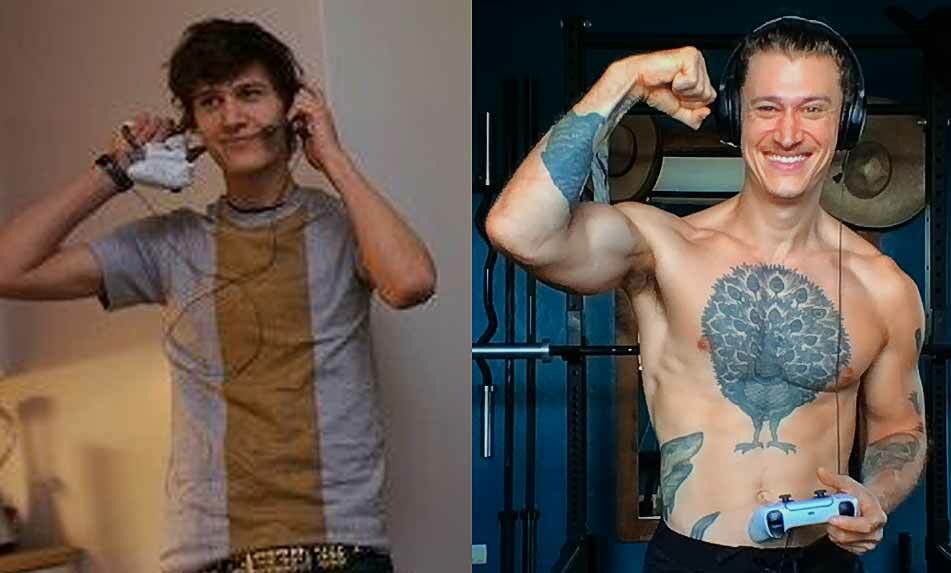
That’s the story of how we went from skinny to muscular. Jared ultimately gained 50 pounds. Marco and I have each gained 70. It transformed our physiques, our health, and our entire lives. That’s why we’re so passionate about helping other skinny guys bulk up.
Conclusion
If you’re a naturally skinny guy and you want help building muscle, check out our Bony to Beastly Bulking Program. We’ve been doing this full-time for almost ten years, with over 10,000 satisfied clients. I think you’ll love it.
- Hypertrophy training: we’ll teach you how to lift for muscle size and give you a detailed routine to follow. Marco will teach you every single lift and progression with tutorial videos.
- Bulking diet: we’ll teach you how to eat for weight gain. Instead of restricting foods to facilitate weight loss, we’ll teach you what to add to your diet, what macros to emphasize, teach you the best bulking recipes, give you sample meal plans, and teach you how to build your own perfect bulking diet.
- Lifestyle optimization: even just improving your sleep can speed up your muscle growth by 30% while radically reducing fat gain. By combining hypertrophy training with a bulking diet and a healthy lifestyle, you can bulk up quicker, more leanly, and with better improvements to your health.
But perhaps most of all, there’s our online coaching community. We’ll teach you how to take proper progress photos and do a “before” assessment. We’ll help you adjust the program to suit you better, give you feedback as you post progress updates, and help hold you accountable. And you’ll be surrounded by other skinny guys working towards the same muscle-building goals as you are. For me, that was what finally allowed me to build muscle consistently.
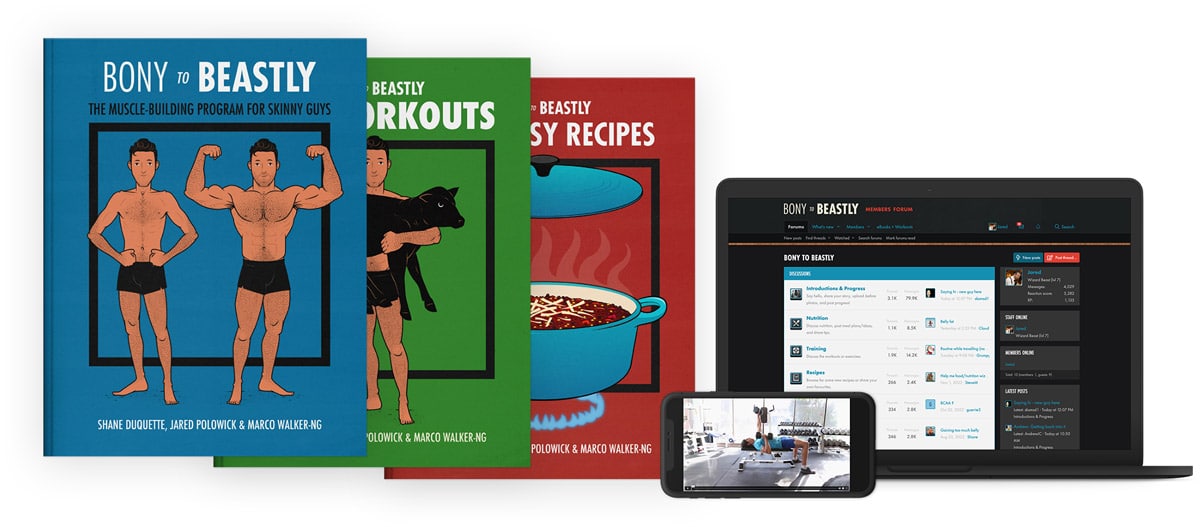
If you want more muscle-building information, we have a free bulking newsletter for skinny guys. If you want a full bulking program, including a 5-month workout routine, diet guide, recipe book, and online coaching, check out our Bony to Beastly Bulking Program. Or, if you want an intermediate bulking routine, check out our Outlift Intermediate Bulking Program.
Shane Duquette is the founder of Outlift, Bony to Beastly, and Bony to Bombshell, each with millions of readers. He's a Certified Conditioning Coach (CCC), has gained 70 pounds, and has over a decade of experience helping more than 15,000 people build muscle. He also has a degree in fine arts, but those are inversely correlated with muscle growth.
